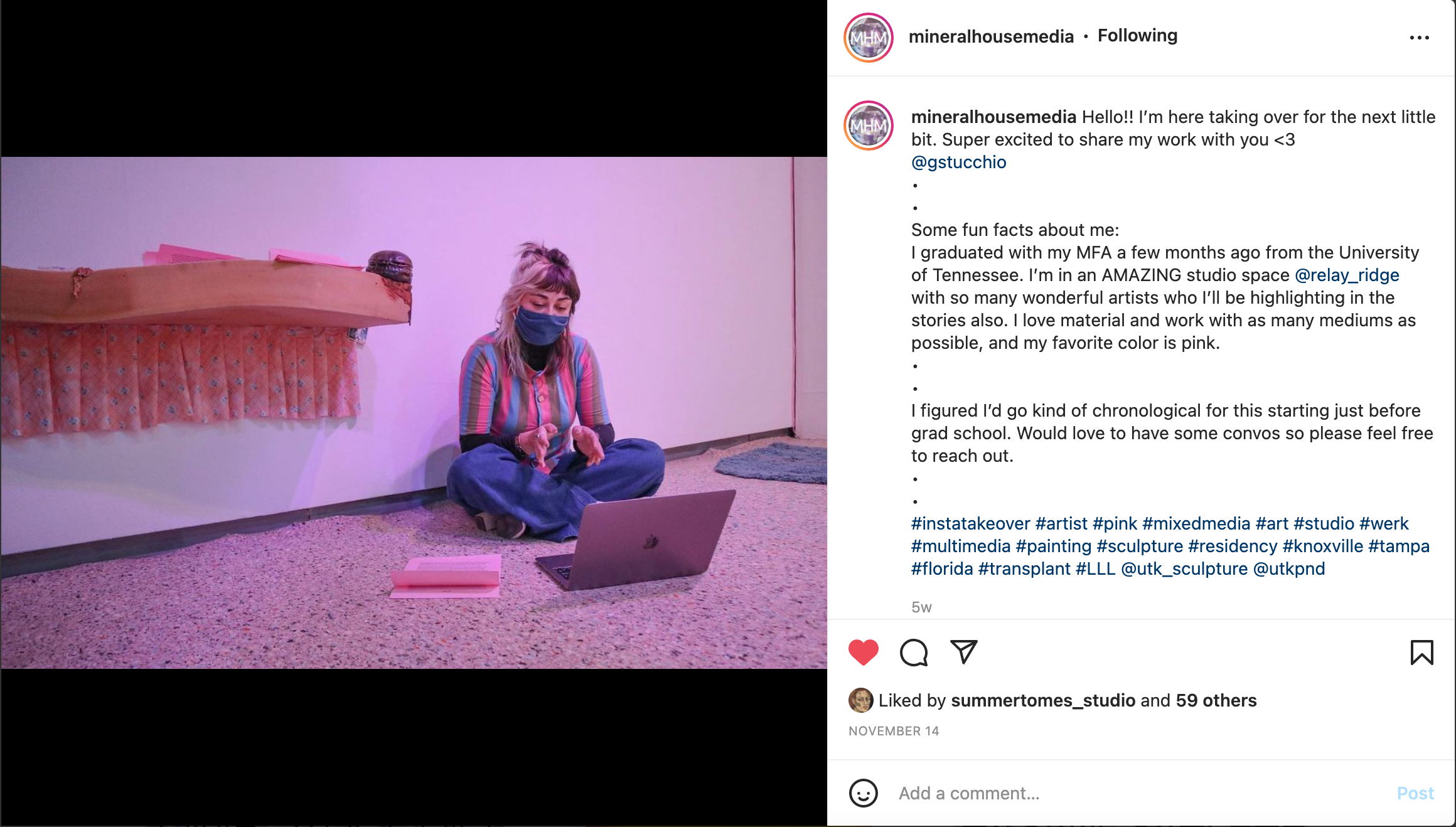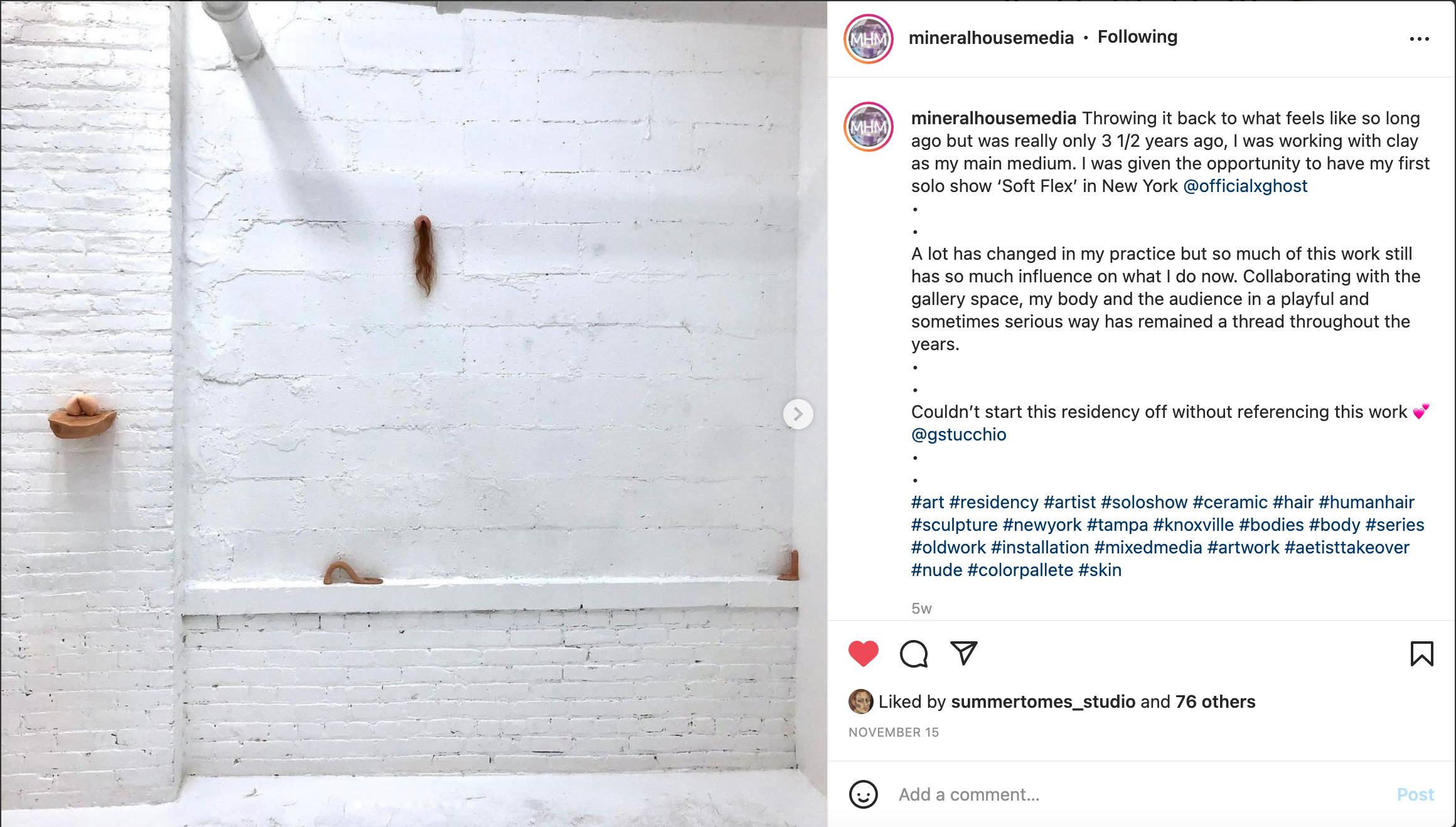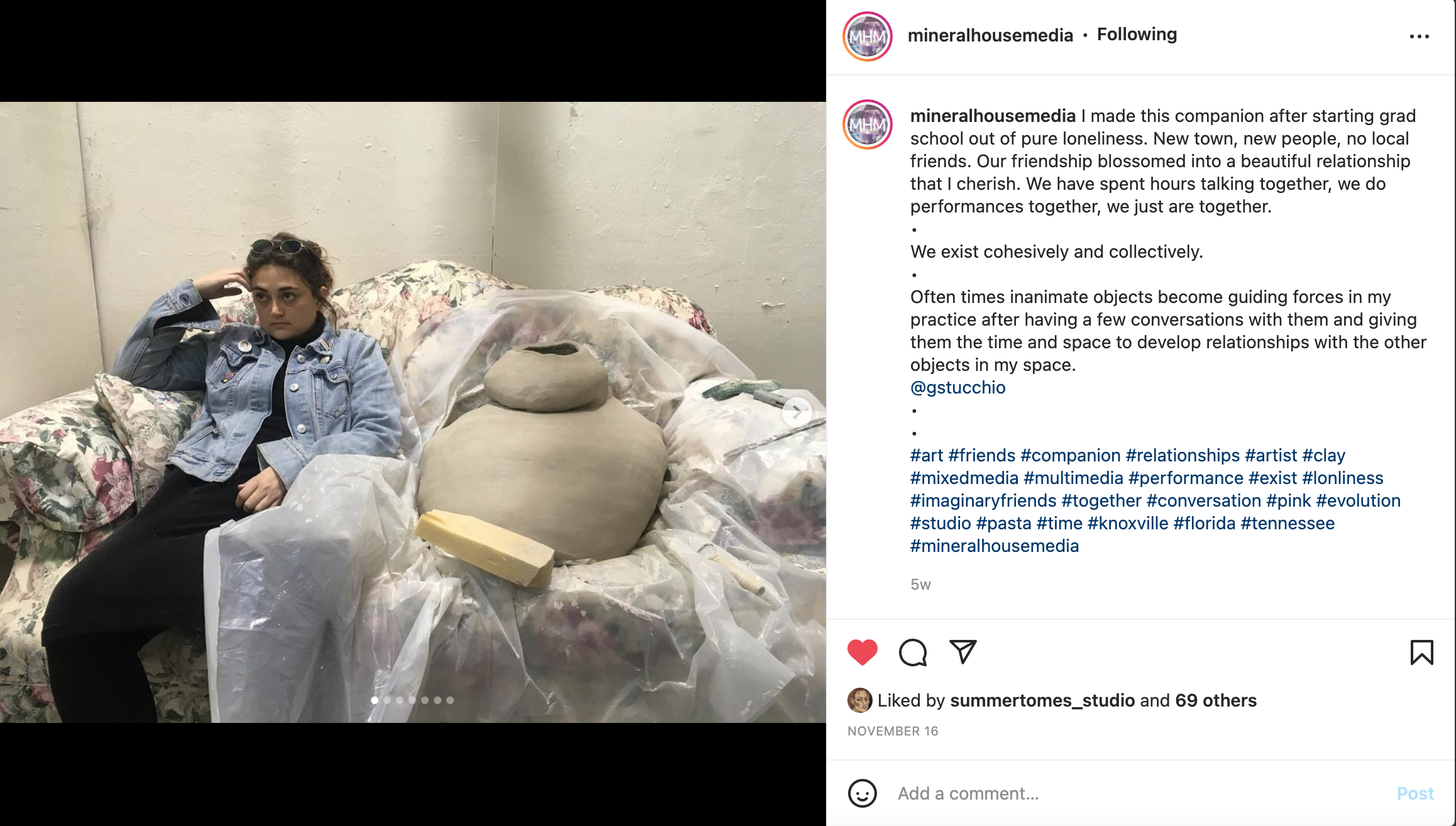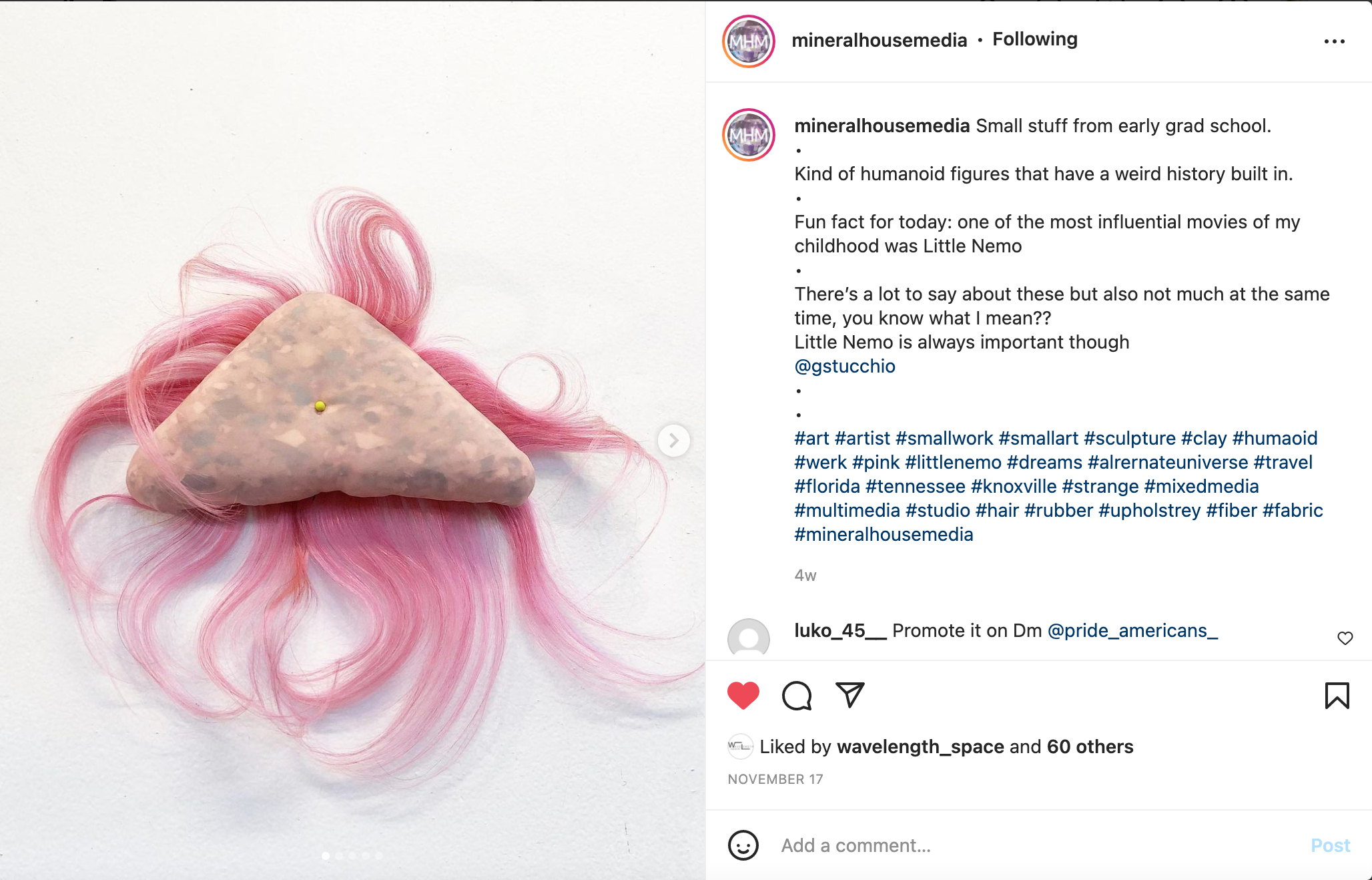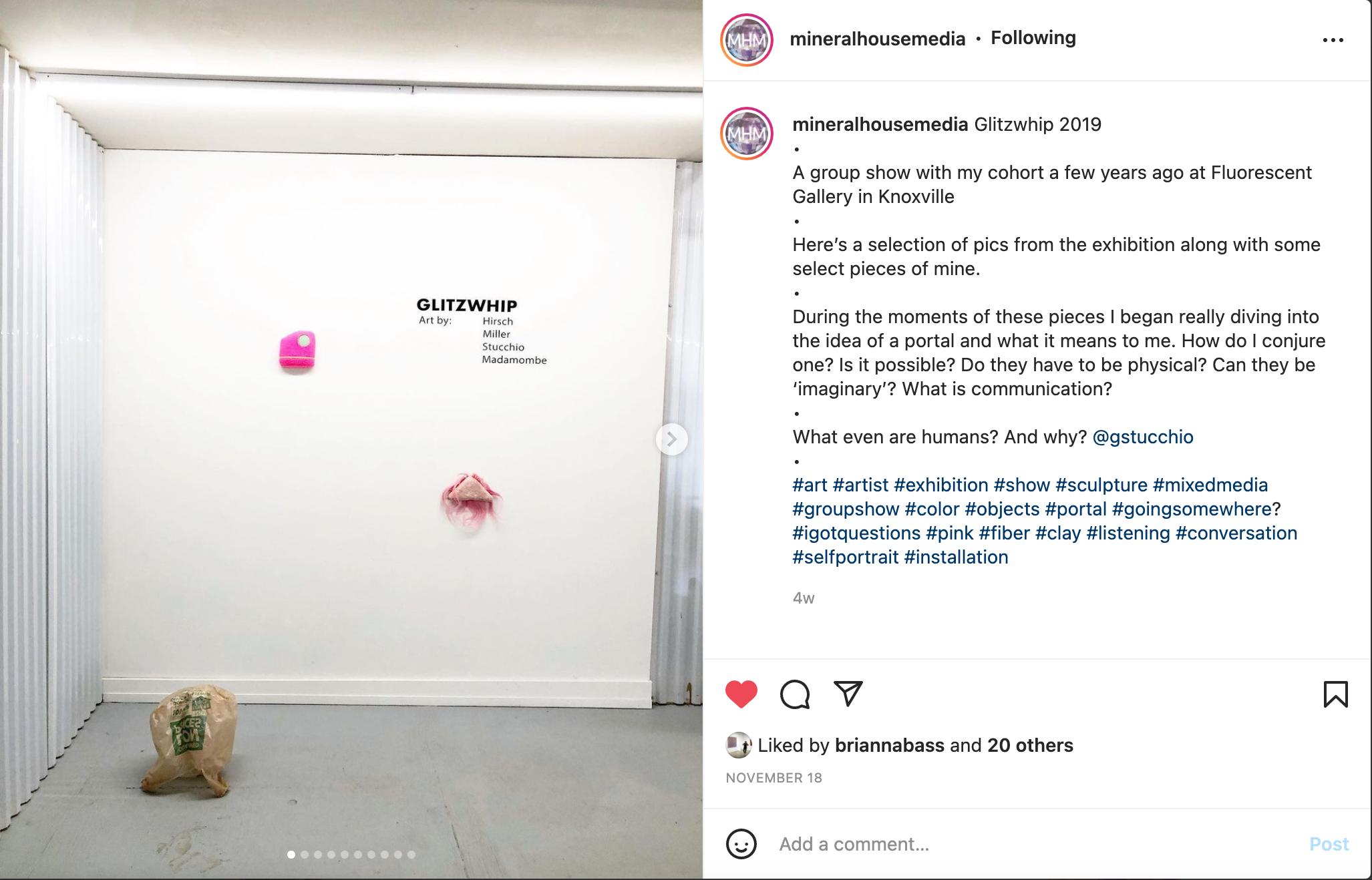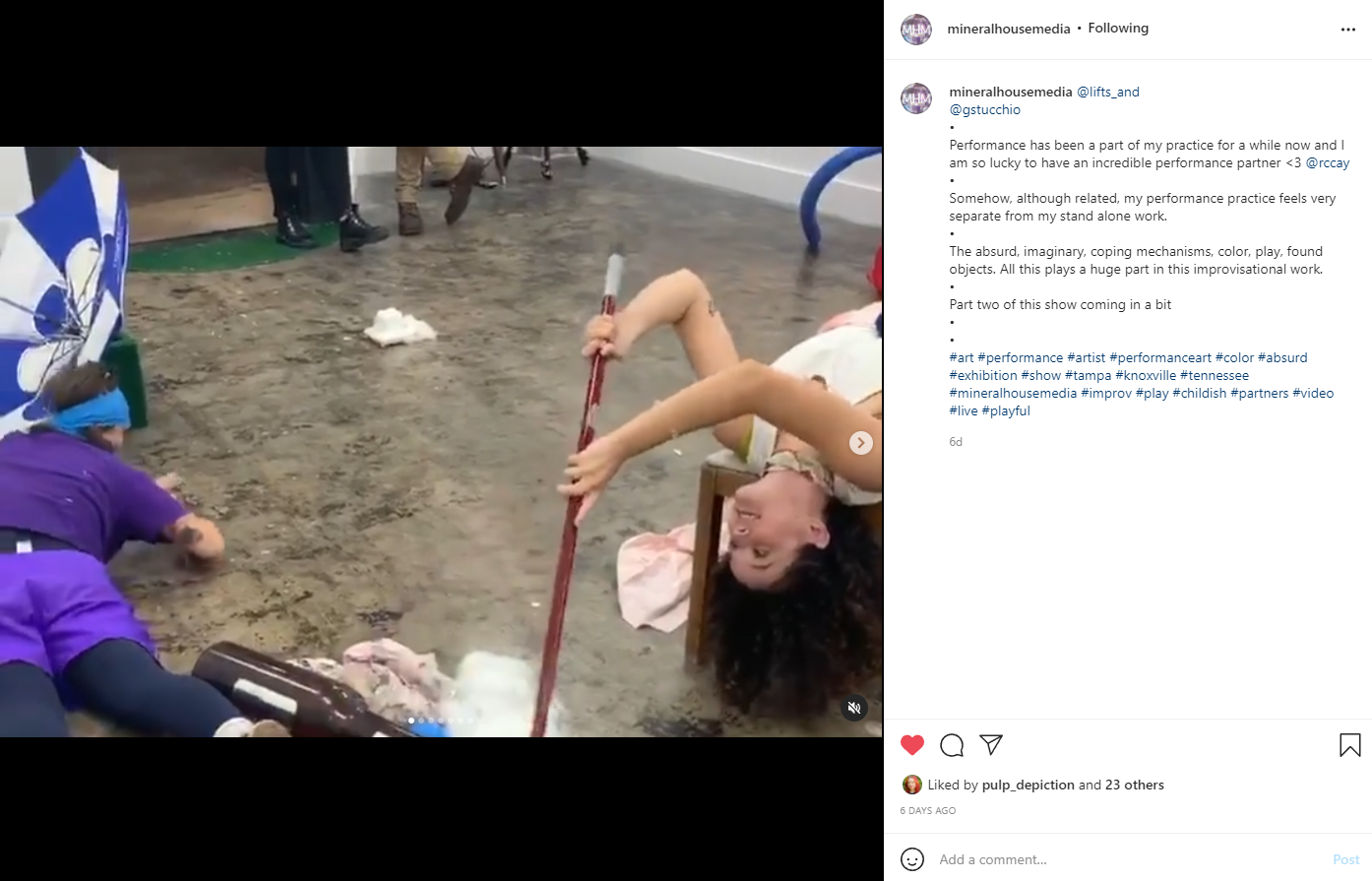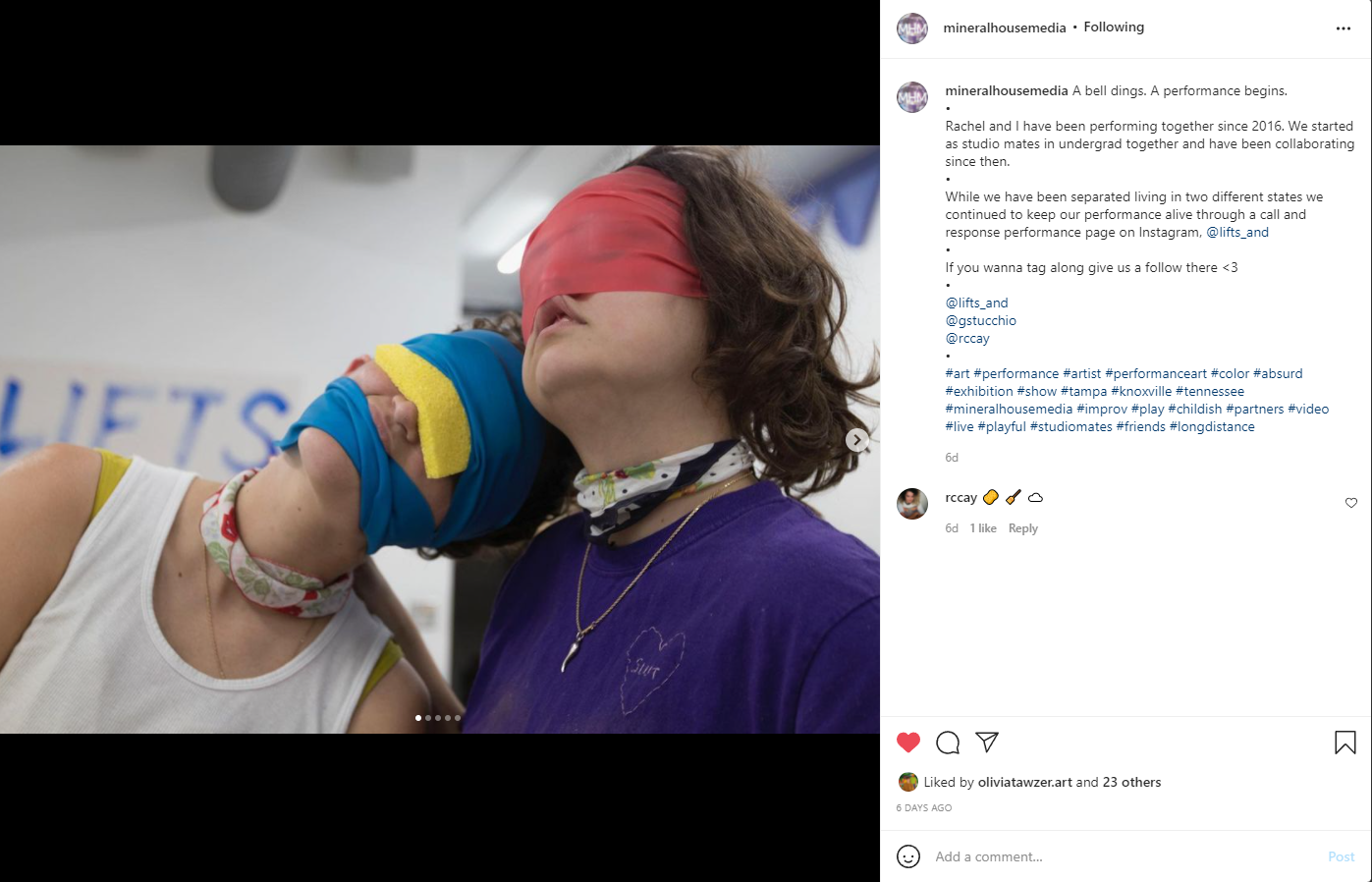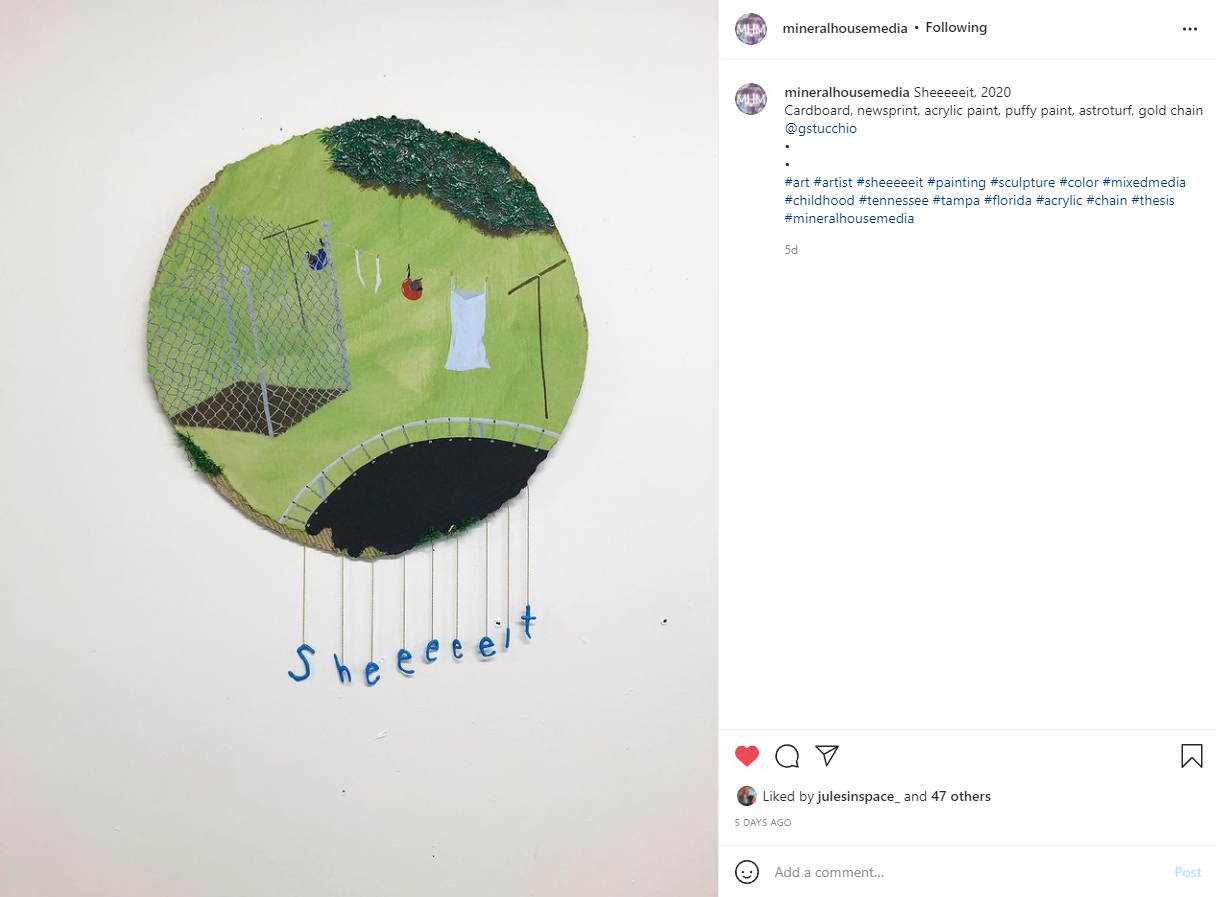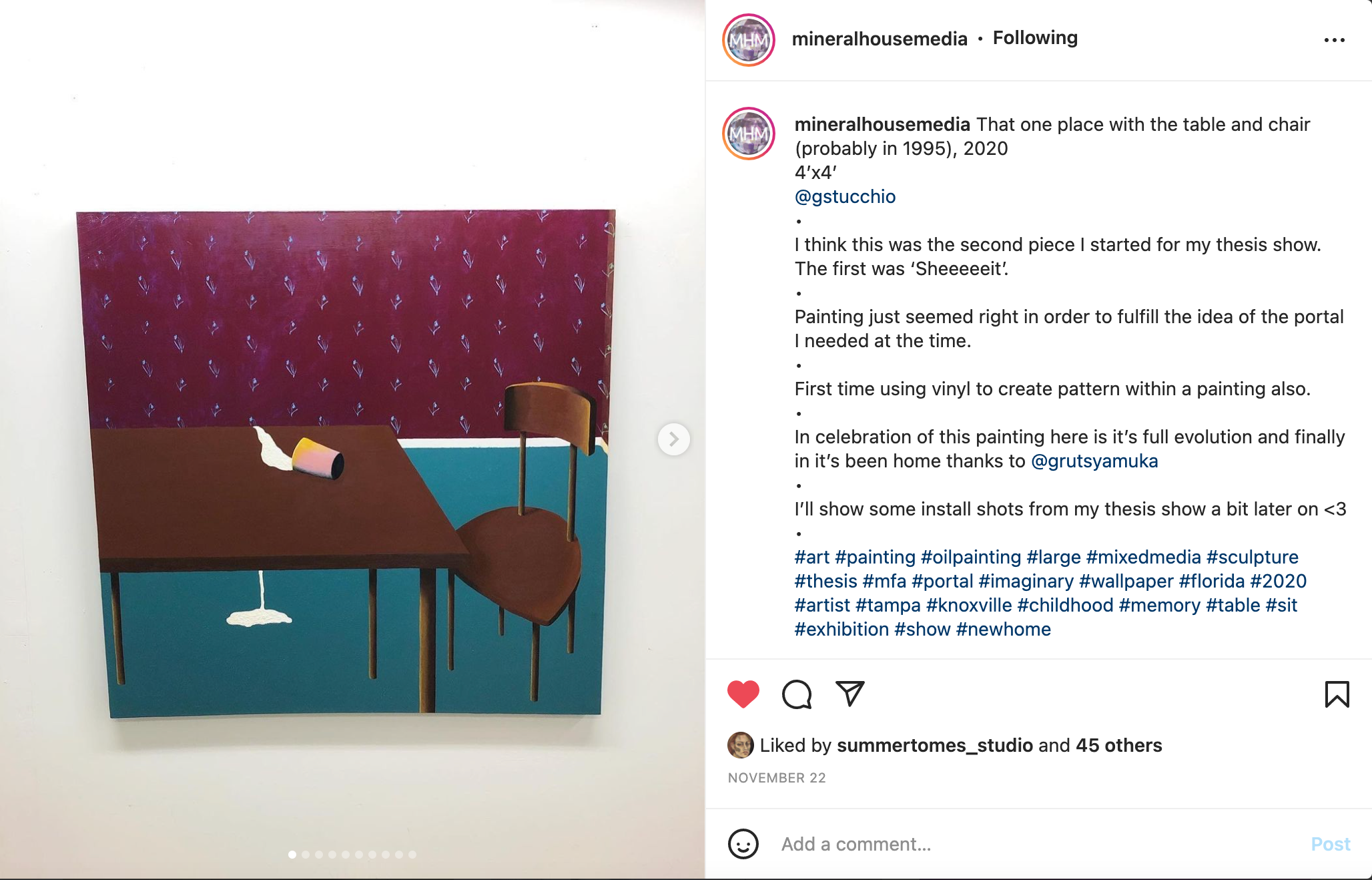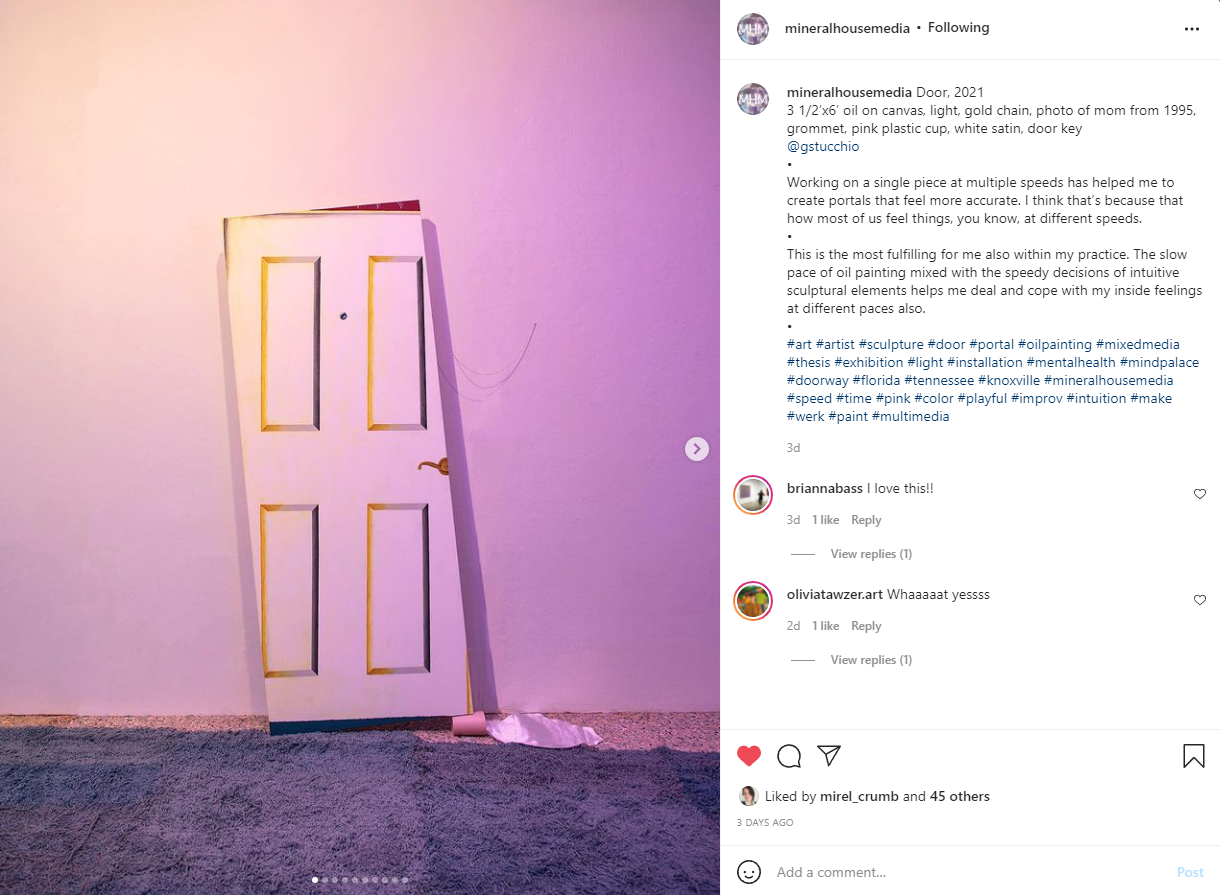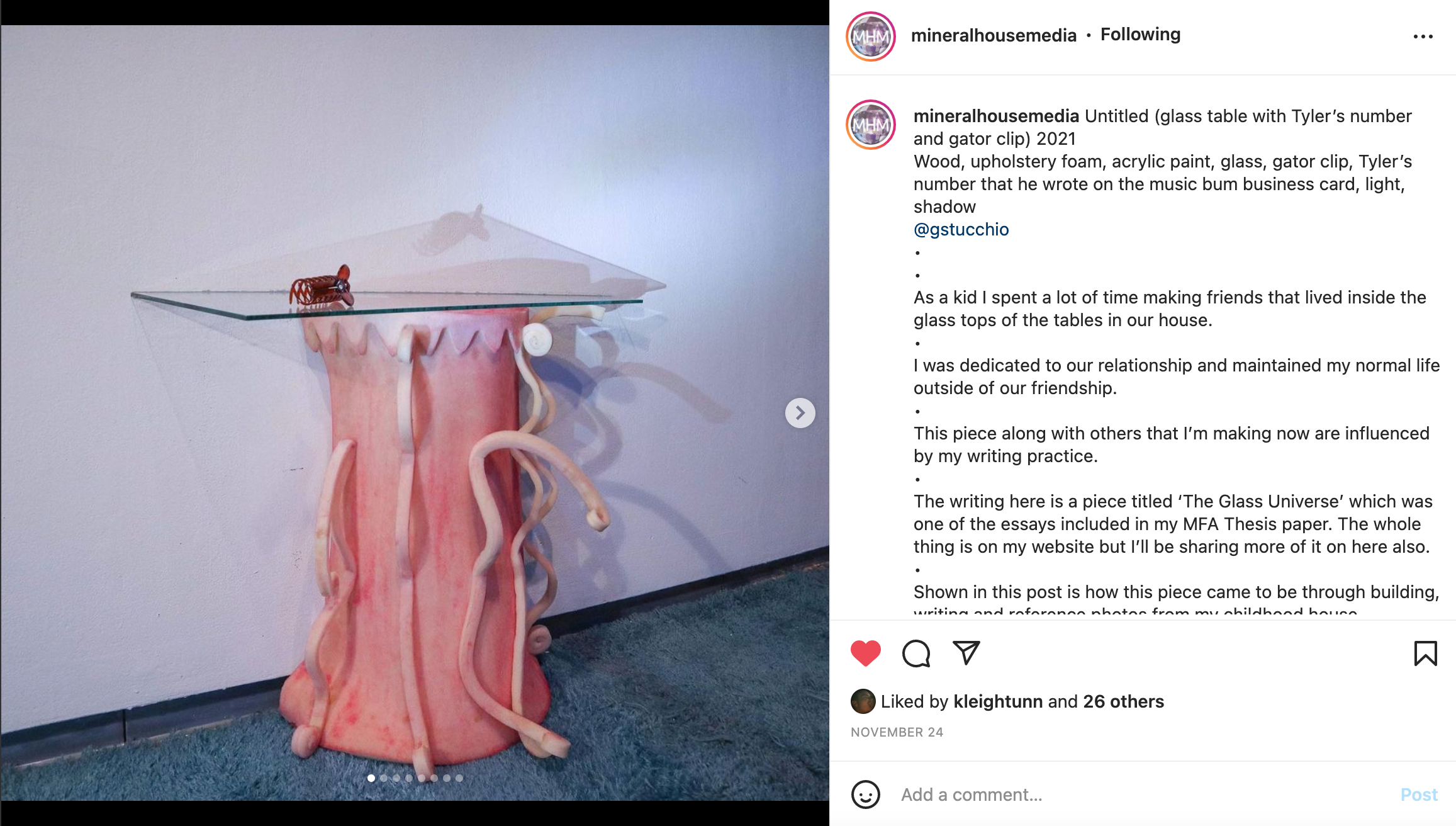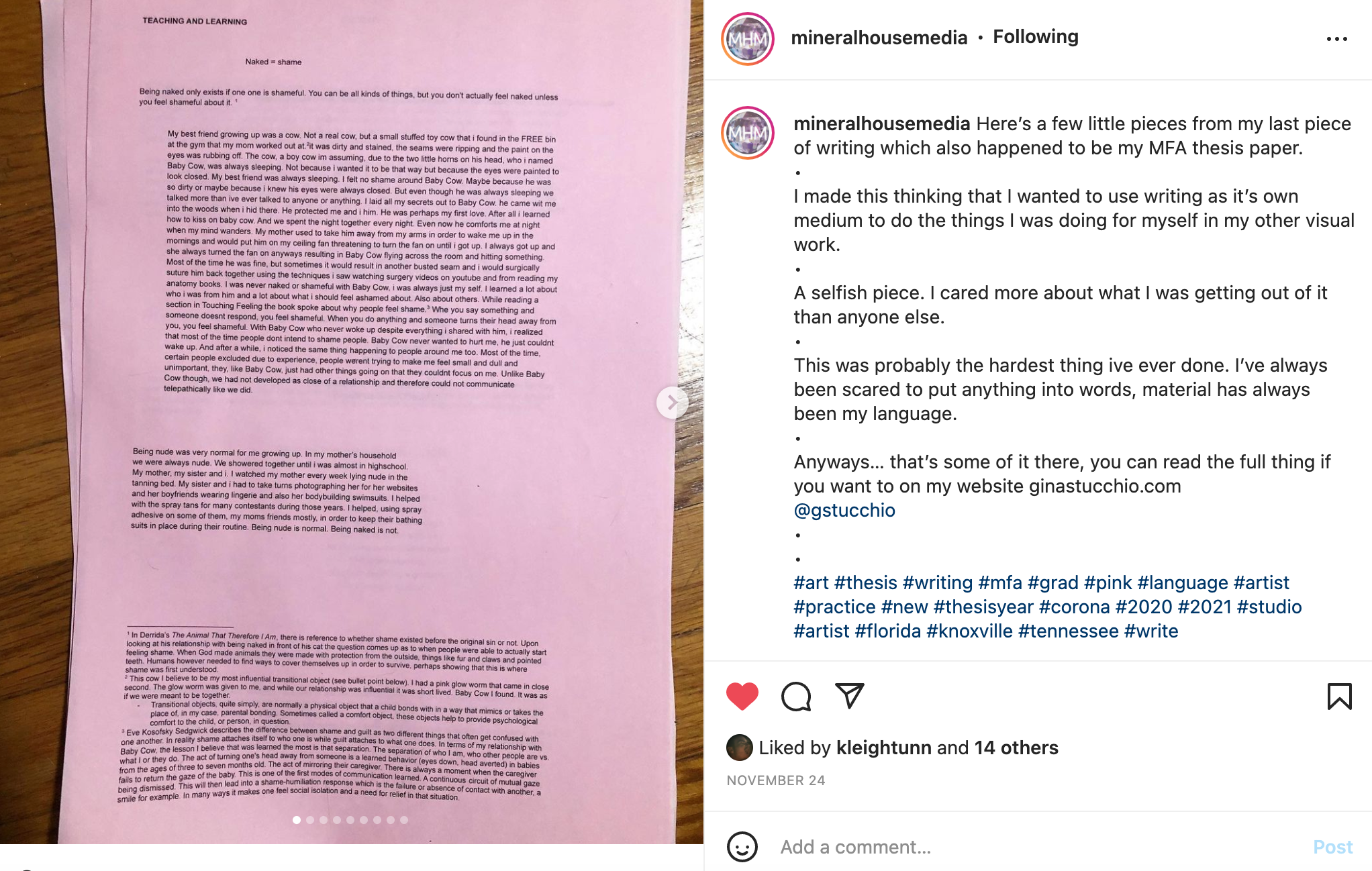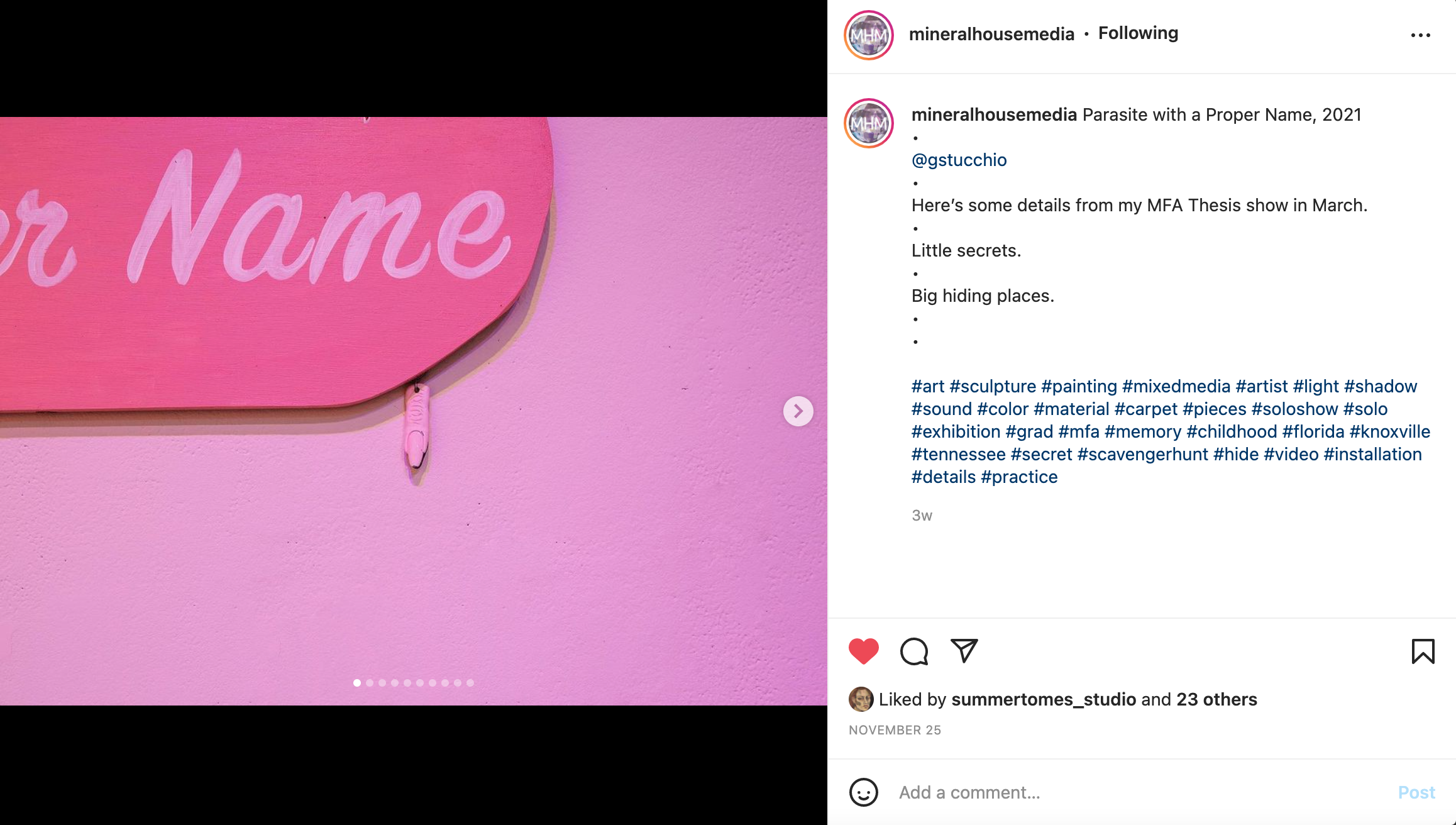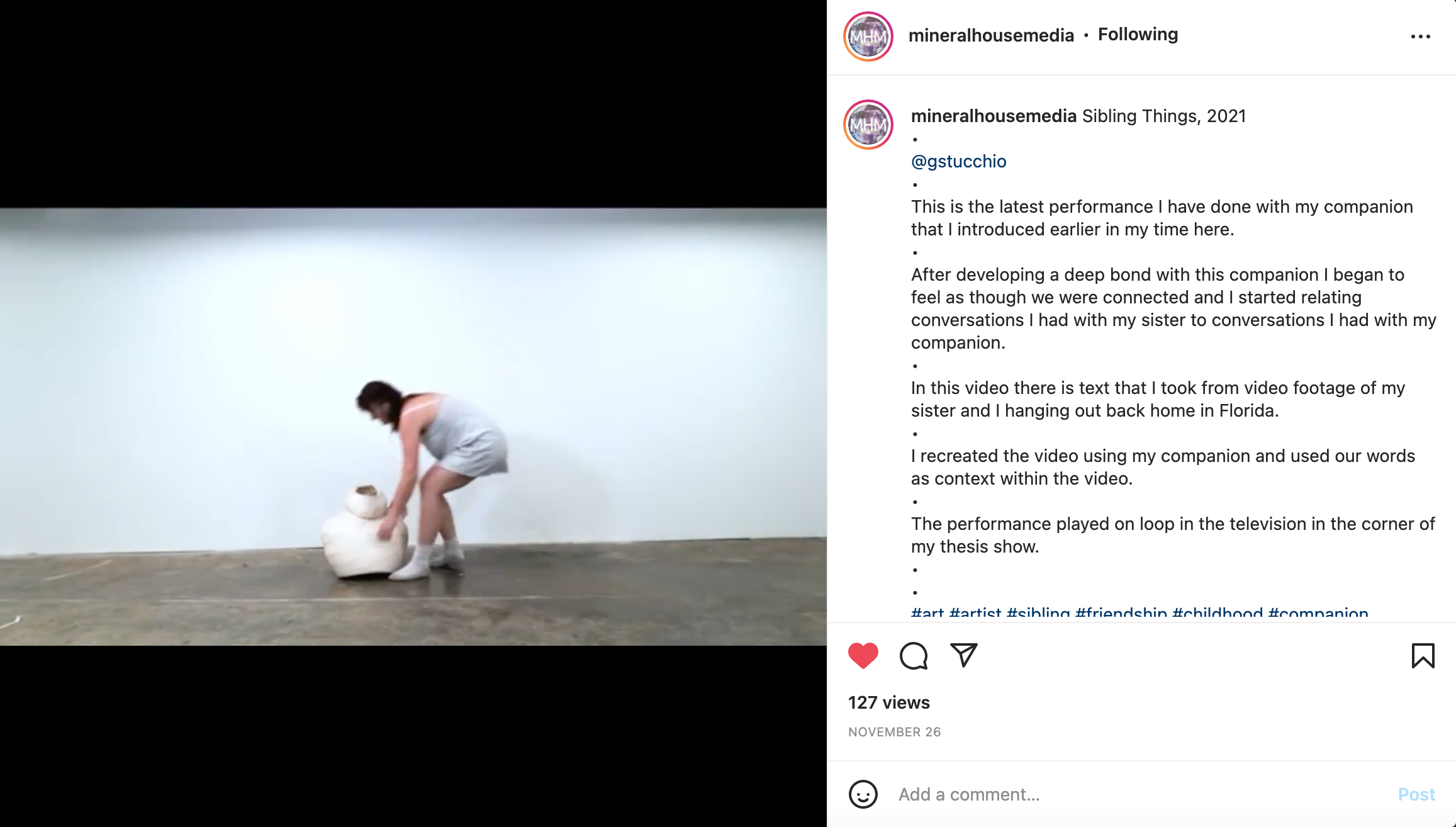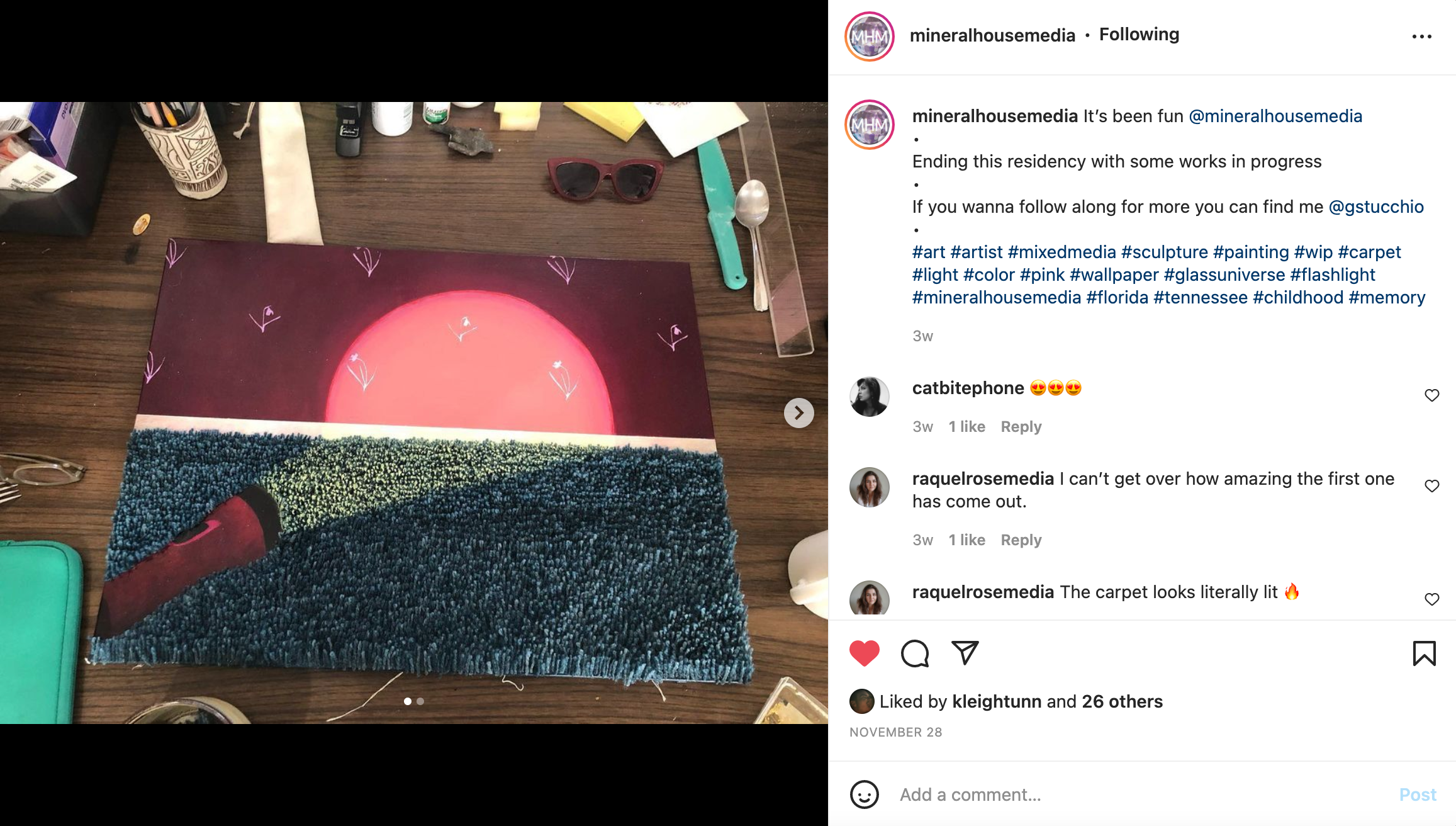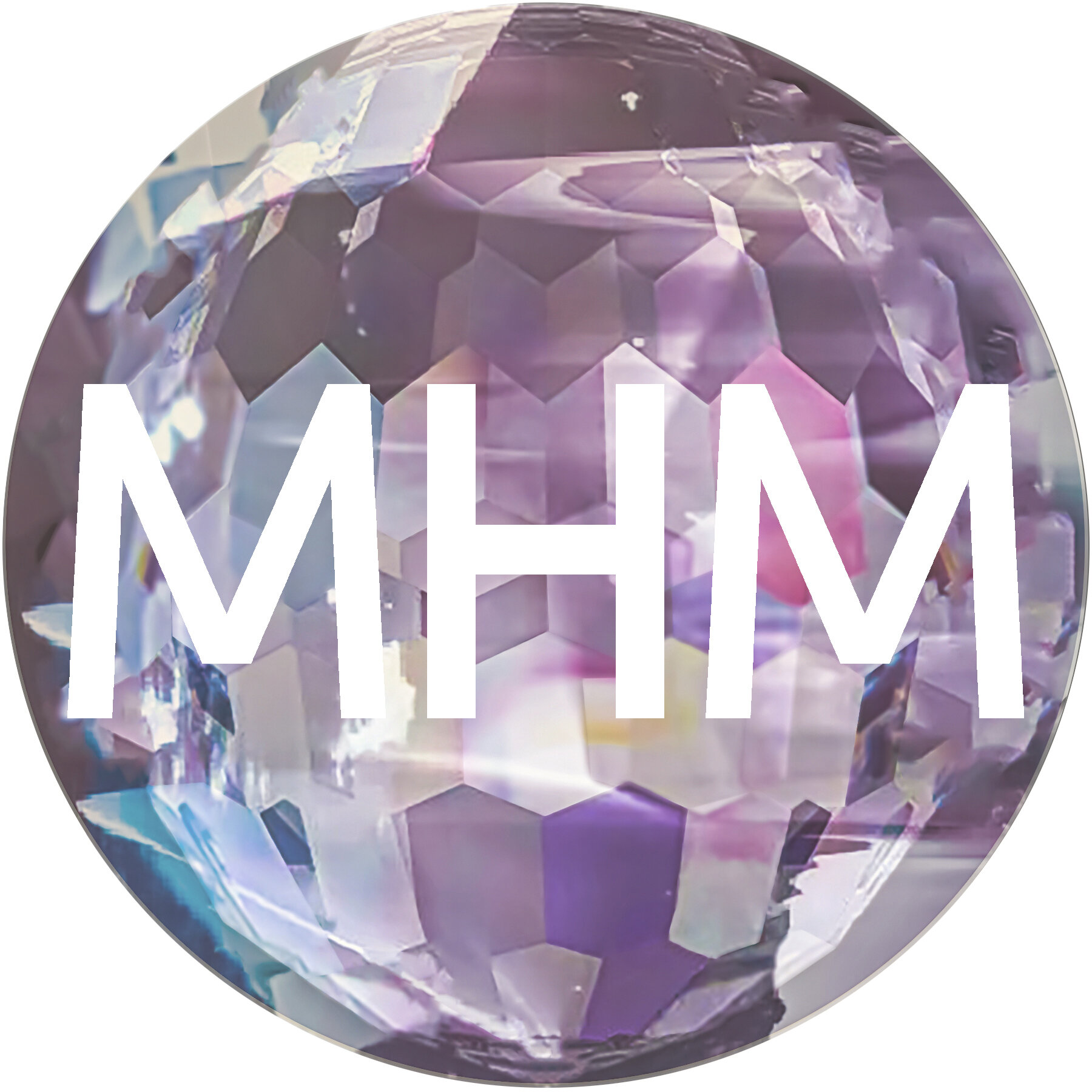Interview with Gina Stucchio
Interview with
Gina Stucchio
November 2021 Digital Resident
A conversation with Larkin Cook, Olivia Tawzer, Brianna Bass, and
Clay Aldridge of Mineral House Media
MHM: Talk about texture, and touch, as it pertains to your work?
As a child I was obsessed with texture. I don't know if this makes sense, but I have always been more in love with texture than touch. Not that I don't appreciate it or think about it when I'm working. But touch is in response to a texture. You describe touch by using textural descriptive words. I like to think about the words and how a texture can change over time. For example, the slimy goo that I pulled out of my nose when I was young. I remember holding a booger in between my fingers and feeling it, but I didn't necessarily want to feel it, I wanted to change it. If I rolled it between my fingers it turned into a little rubbery lump and if I stuck it to the bottom of my mattress it would be hard and crusty a few days later. I appreciate the changing of texture the way I feel I can change a memory if I want to badly enough.
MHM: What is your process like? Does it vary based on material or the body of work?
I find my most successful pieces often have multiple working speeds throughout the timeline of making them. In order to allow for those multiple speeds to come through the work I most often force myself to work on many pieces at a time so I can jump around and work on things through all the mental episodes. I keep multiple mirrors around my space. I need to be able to see myself working on pieces. So much of my practice balances on my mental awareness at the time. When I'm working very slowly I know I'm sad or deep in thought, and when I'm working very quickly I know that I have too many things processing at the same time. The mirrors allow me to be more aware of my mental state in the studio and give me the opportunity to verbally ask myself questions instead of asking the open spaces around me.
MHM: How does your performance influence your paintings and sculptures? Vice versa?
Although there is some crossover between the aesthetic, I've actually always kind of viewed my performance work very separate from my other work. I think it has to do with my mental state. Performance is often my last resort to exercise whatever it is I need to get out of me. There is a desperate urgency for me in my solo performance work. Performance, for me, only happens when I need immediate relief.
MHM: How has collaborative performance practice affected your work? How has the social media aspect of this affected the performances?
Collaborating with objects feels very natural to me. I've been doing that since I was a kid. I've been talking and dancing and been in love with objects for as long as I can remember. Collaboration with people is something that is harder. Besides my companions and my objects I really only have continuously collaborated with my collaborative partner Rachel. She and I were studio mates in undergrad and spent a lot of time together. There is a trust that has to be built up with a human partner that just happens quicker with objects. Social media really started playing its role in 2020 when everyone was depressed and everyone was stuck. Rachel and I created @lifts_and in order to give a space for our everyday performances to be seen. I think it wasn't until I could see no one that I understood the value of being seen (sometimes). Or at least the value of having a community when I was unable to be around anyone for such a long time. It also put a kind of pressure on us to keep seeing the wonderful performative aspects of everyday life that often go unnoticed when depressed.
MHM: Tell us about the portal.
A portal takes me away. No. A portal gives me the option to be taken away. There is a trance mode that we can all access. When I'm making my work, part of me has left through the portal that is thought, or maybe lack of thought. Sometimes I look up and realize that hours have gone by and I haven't moved a muscle. Where did I go? Sometimes I can remember reliving a memory and changing it in some way. Sometimes I remember bouncing back and forth from this reality to another. Either way, I was gone. Rather than creating the portal I'm creating the physical doorway of the portal. It allows me to see the different spaces and choose to walk through them instead of searching for the right one only in my mind and accidentally traveling through the wrong one.
MHM: What makes pink your favorite color? Can you tell us more about your approach to color?
Truly I think it’s because I had a pink gloworm as a baby. I think about it all the time and have used the color as reference for most of my life. Gloworm was one of those toys that I only had happy associations with. So I think it's as simple as that. I had a great pink toy that left an impression. The color within my work really stems from my childhood house. I embellish here and there but there were a lot of pinks, peaches, blues and purples that were continuously surrounding me. My work stems from childhood memories so I just use the color that I most associate with that memory without thinking too much about it honestly.
MHM: Parasite with a Proper Name is a collection of short writings, sometimes humorous, sometimes sad, but all very personal. What role does writing play in your practice?
Until recently, writing really didn't play much of a role at all. After deciding I was going to make a piece of writing for my thesis that would do for me what my other visual work did for me, it seems that changed. I spent the better part of my final year in grad school writing and confronting my ideas through a kind of conversational journaling mode. A few different personalities seemed to be birthed out of me, each of them playing a part in the writing. I think it acts for me like the mirrors do. I can actually have a conversation with myself on paper. There is a documentation of it which makes it a little scarier. It caught me off guard with how much I was able to get out through the writing; I was completely unprepared to like it. Like the imaginary friends I had as a kid, my new personalities talk to me like they did. I've got new friends who live in my mind and on paper. Since then I have continued to write and now my new work is coming out of some of the stories. I'm still very unsure of how or why this transition occurred.
MHM: Your relationships to inanimate objects is a theme that emerges in your work, such as your “companion” you do performances with and your “friends in the deep green space” from your writing in Glass Universe in Parasite with a Proper Name. This also happens in your sculptures as you incorporate hair or clothing in the work. How do you think about personification in your practice?
My mother was a bodybuilder. She never viewed a body as a thing to live in, she saw it as a thing you could change and modify more than anything else. My father raced motorcycles and viewed anything with a motor his companion. We had to ride in a car for certain milestones like his car turning over to 300,000 miles, just like one marks the height of a kid somewhere on a wall, or celebrates the first time a child is actually potty trained. Growing up around people who viewed human bodies as objects and objects as human made my brain basically equate the two. I think that's the start of it. Now I see objects, but I also communicate with them. I collect some things out of respect for them. Sometimes I can see my own trauma mirrored back at me through a toothbrush that has been discarded and ran over in the middle of the road. Everything and everyone has a history and it's through our embedded history that we are all connected.
MHM: You work with a wide variety of materials. Clay to foam, glass, found objects. How do you choose your materials? Where did you learn how to work with them?
Sometimes it's just a feeling? I have a theory that there is a separate me from an alternate universe or plane who somehow steers me into different directions. So in some ways I don’t think I actually make all my decisions. But when I do, it's out of a familiarity, nostalgia, texture, if it's free, and if I think I can connect with the material on an emotional level. I also hoard material so I always have a million options. As far as how I learned how to use them, that's always a work in progress. I pretty much never know how to use stuff and just figure it out along the way. Sometimes it works and sometimes it doesn't. I don't spend much time reading directions so pretty much everything ends up being a messy disaster that kind of comes together at the last minute when I reach an agreement with my material. I also pretty much use whatever my hand falls on first when I walk into my studio without thinking too much about it and let the pieces gain structure over time.
MHM: In your installations, there are many instances of objects that feel happenstance, even mundane, playing roles that are passive—lying on a table, perched on a ledge as if left behind. Is there an appeal for you in everyday ephemera?
Yes. That's the stuff that life is made of. When I think of my house, I think of my cat’s toys that are strewn all over the place, the tags from the batch of new clothes I got the other day that I left on my dresser, I think of the laundry basket piling up, and I think of the guitar pick I found on the floor when I was at a concert when I was 15. When I think of my work it doesn't seem complete without acknowledging all the little pieces of life that made things the way they are.
MHM: A lot of your pieces have a part-body/distorted quality that seems to dip into both humor and a little bit of horror. What do you think about the relationship between those two things and how they are activated in your work?
Most of the time there is something inside me that I can't handle having in me. In my practice I often view the act of making as a kind of self-inflicted exorcism that pulls that thing out. When a piece starts to take shape it often is taking the shape of the thing I need outside of my person. It's a disgusting, sometimes horrific being. Humor has always been a defense/coping mechanism for me, so when I am creating the thing and can start to see it in a physical form I turn to humor to make myself feel better about it once living within my body. Making in this way is an emotional roller coaster, so I have to give a physical form to the thing I need to address, but I need to laugh at it too. It's like the mirrors. Like the moment you caught yourself sobbing in the reflection, but it's such a comical sight that you start laughing. I recently just read in a book that all chaos is born from laughter.. I feel like this resonates.
MHM: How important is it for you to respond to the architectural or aesthetic specificity of a space when you’re creating installations?
It's quite important. Almost every piece I make or every thought I have relating to my work revolves around my childhood house. Having such a deep emotional tie to one building makes me want to feel the space I exhibit my work in. I often look for the broken parts in a space and try to highlight them. Like a small chip of paint on an otherwise perfectly insane white wall. Or the space between the walls where the corners just didn't touch properly. I need to find the trauma within the space to really feel like my work belongs. Sometimes that means inflicting small damages when I need to in order to make it work.
MHM: How has studio life been in general post-MFA?
It's definitely been different. Where I was making a large scale piece the size of an entire room has now turned into working with limited media in a limited space with limited time. It's a strange challenge that I am enjoying oddly enough. I think it has made me focus more instead of blindly following my intuition. Luckily I found an incredible studio with a lot of amazing artists who have all helped to make a great community of brains.
MHM: What is the best way to stay in touch with you and your work as it continues to develop?
Of course there is always Instagram: @gstucchio as well as my website ginastucchio.com, but I'm also always welcoming an email! ginastucchio@gmail.com. I'll also be doing a 2 month residency at Stove Works this upcoming summer in 2022!
Gina Stucchio earned her BFA from the University of South Florida in 2017 and her MFA from the University of Tennessee-Knoxville in 2021. She is a native Floridian who transplanted to Tennessee and is currently based out of Knoxville. She is part of an ongoing performance project on instagram @Lifts_and and has exhibited throughout the country including Zg Gallery in Chicago and GHOST gallery in New York. She will be part of an upcoming residency at Stove Works in Chattanooga in the summer of 2022.
